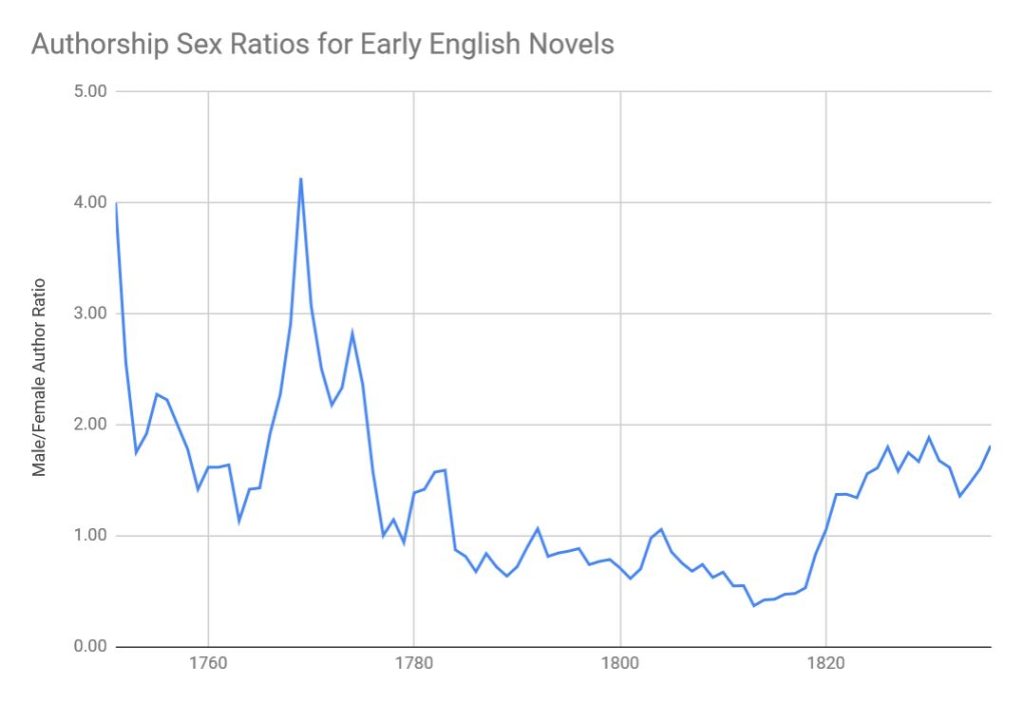The rapid growth of novels in late eighteenth-century England was an important communications industry development. A large number of manuscripts of novels were available to printers at low cost. Printing novels was a profit-driven business, as was book-selling and book-lending through commercial circulating libraries. Printers chose novels to print with keen regard for market demand. Hence studying what novels were printed provides insight into what readers sought.
Female authors predominated among the authors of English novels for about thirty-five years after the production of novels rose sharply. The number of new novels printed in Britain and Ireland roughly doubled from the first half of the 1780s to the second half of the 1780s, rising above 50 novels per year and remaining above that level permanently. Across the years from 1785 to 1819, the median ratio of male-authored novels to female-authored novels was 0.69, meaning that male-authored novels numbered about 31% fewer than female-authored novels.[1]

[graph with underlying data and source citations here]
Printers probably favored female authors because they judged female authors to have better prospects of successfully serving readers’ demands. Female authors on average probably understood the literary demands of female readers better than male authors did. Hence the sex ratio for authors suggests that, for thirty-five years after novels became a much more popular good, female readers predominated. These were also the years when women workers, including married women, were a large share of the new cotton factory workforce. Thus, even when women were taking jobs outside the home in a new, high-profile segment of the economy, women probably were also spending more time reading fiction than were men.[2]
Given the biological facts of human sexual reproduction and the evolutionary creation of the human animal, one should expect the behavior of males and females to differ significantly. In the contemporary U.S., men are much less likely to read literary works than are women. Taking sex differences seriously is important for thinking about the development and marketing of communication services.
* * * * *
Read more:
- growth of novels in 18th-century England
- the books in Thomas Jefferson’s library
- Scudéry, Richardson, and long tales
Notes:
[1] The ratio of male-authored to female-authored novels is not the same statistic as the ratio of male authors to female authors of novels, because some authors wrote multiple novels. Raven (2003) p. 150 declares that the latter statistic is “far more significant” than the former, but does not clearly specify why. From 1770 to 1799, the number of male authors of novels was 54% greater than the number of female authors of novels. See Raven (2000) p. 41. Since authorship of novels typically generated little profit in money or social status, the latter statistic indicates that authorship disadvantaged men more than women. Authors, however, were a much smaller share of the population than were readers.
[2] Tepper (2000) analyzes the “gender gap” in fiction reading in the U.S. This work notes that fiction reading is “passive and generally home based” and states that “girls are still socialized into passive, private and non-competitive activities, while boys are channeled into activities which tend to be aggressive, competitive, creative, and leadership-oriented” (p. 272). It cites an authority who declares that “inequalities persist for women in their opportunities for leisure” and concludes that socialization accounts for women reading more fiction than men (id.). Tepper seems not to have considered the possibility that particular patterns of socialization of males and females are part of evolved human development paths and might be extremely difficult to change without tyrannical force. Note that Tepper’s concern about women’s fiction reading goes against the fundamental theme of the NEA’s study, Reading at Risk. Neither Tepper (2000) nor Reading at Risk shows much concern for men.
References:
Raven, James (2000), “Historical Introduction: The Novel Comes of Age,” in The English novel, 1770-1829: a bibliographical survey of prose fiction published in the British Isles, gen. eds. Peter Garside, James Raven, and Rainer Schöwerling (Oxford: Oxford University Press), vol. 1, pp. 15-121.
Raven, James (2003), “The Anonymous Novel in Britain and Ireland, 1750-1830,” in The faces of anonymity: anonymous and pseudonymous publications from the sixteenth to the nineteenth century, Robert J. Griffin, ed. (New York: Palgrave Macmillan), Ch. 6.
Tepper, Steven J. (2000), “Fiction Reading in America: Explaining the gender gap,” Poetics 27, pp. 255-75.





